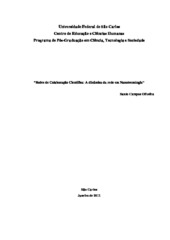| dc.contributor.author | Oliveira, Saulo Campos | |
| dc.date.accessioned | 2016-06-02T19:16:27Z | |
| dc.date.available | 2011-04-27 | |
| dc.date.available | 2016-06-02T19:16:27Z | |
| dc.date.issued | 2011-02-23 | |
| dc.identifier.citation | OLIVEIRA, Saulo Campos. Networks of Scientific Collaboration: the dynamics of networks in Nanotechnology. 2011. 132 f. Dissertação (Mestrado em Multidisciplinar) - Universidade Federal de São Carlos, São Carlos, 2011. | por |
| dc.identifier.uri | https://repositorio.ufscar.br/handle/ufscar/1060 | |
| dc.description.abstract | The scientific collaboration is one of the indicators to measure the development of research and progress in scientific discoveries. Serves, in other words, in conjunction with other indicators to measure and understand how science develops and direct investment in research. In this study area in particular, nanotechnology, the analysis of scientific collaboration network, converges to an alternative interpretation of the implementation of the Nanotechnology Brazilian Network. This study seeks to analyze the Brazilian scientific collaboration using the methodology of network analysis, together with the technique for generating bibliometric indicators of collaboration in the field of nanotechnology with data extracted from the database Web Of Science in the period 1998 to 2009. To guarantee this, it was necessary to experiment in different view settings for the network organization with the support of the representation of networks in specific software for Social Network Analysis (UCINET) and covalidation results with an expert participating in the network in search of information for the results obtained.These results show the comparison between the main actors of the network using the measures of Degree Centrality, Degree of Intermediation and Degree of Proximity evaluate the role and the relationship between authors and countries in terms of external collaboration and institutionsresearch and Brazilian states in terms of internal collaboration. It also pointed to the involvement of institutions of the State of São Paulo, especially UFSCar, this issue.Concludes by highlighting the importance of the use of methodological tools for evaluating the collaborative process of research and showing changes in the profile collaborative in the Nanotechnology in the analyzed period, which occurs in parallel with the implementation of the network in Brazil. | eng |
| dc.format | application/pdf | por |
| dc.language | por | por |
| dc.publisher | Universidade Federal de São Carlos | por |
| dc.rights | Acesso Aberto | por |
| dc.subject | Desenvolvimento da ciência e tecnologia | por |
| dc.subject | Estrutura
social | por |
| dc.subject | Bibliometria | por |
| dc.subject | Análise de Redes Sociais | por |
| dc.subject | Redes de Colaboração | por |
| dc.subject | Nanotecnologia | por |
| dc.subject | Social Network Analysis Collaboration Network | eng |
| dc.subject | Nanotechnology | eng |
| dc.subject | Bibliometrics | eng |
| dc.title | Redes de colaboração científica: a dinâmica da rede em nanotecnologia | por |
| dc.title.alternative | Networks of Scientific Collaboration: the dynamics of networks in Nanotechnology | eng |
| dc.type | Dissertação | por |
| dc.contributor.advisor1 | Faria, Leandro Innocentini Lopes de | |
| dc.contributor.advisor1Lattes | http://buscatextual.cnpq.br/buscatextual/visualizacv.do?id=B964053 | por |
| dc.description.resumo | A colaboração científica é um dos indicadores para se mensurar o desenvolvimento das pesquisas e o progresso nas descobertas científicas. Serve, em outras palavras, em conjunto com outros indicadores, para dimensionar e compreender como a ciência se desenvolve e direcionar os investimentos nestas pesquisas. Na área em especial deste estudo, a Nanotecnologia, a análise da rede de colaboração científica, converge como uma alternativa para interpretação da implementação da Rede Brasileira de Nanotecnologia. O presente estudo busca analisar a colaboração científica brasileira fazendo uso da metodologia de Análise de Redes Sociais juntamente com a técnica bibliométrica para a geração de indicadores de colaboração na área de Nanotecnologia com dados extraídos da base de dados Web Of Science no período de 1998 a 2009. Para tal feito, foi necessário o experimento em diferentes configurações de visualização da organização em rede com o apoio da representação das redes em software específico de Análise de Redes Sociais (UCINET) e a covalidação dos resultados com um especialista participante da rede na busca de esclarecimentos para os resultados obtidos. Os resultados deste trabalho mostram a comparação entre os principais atores da rede utilizando as medidas de Grau de Centralidade, Grau de Intermediação e Grau de Proximidade na avaliação da participação e do relacionamento dos autores e países do ponto de vista da colaboração externa e das instituições de pesquisa e de Estados Brasileiros do ponto de vista da colaboração interna. Foi destacada a participação das instituições do Estado de São Paulo, em especial a UFSCar, neste tema. Conclui destacando a importância da utilização de instrumentos metodológicos para a avaliação do processo colaborativo de pesquisas e mostrando as alterações no perfil colaborativo na área de Nanotecnologia no período analisado e que ocorre em paralelo com a implementação da rede no Brasil. | por |
| dc.publisher.country | BR | por |
| dc.publisher.initials | UFSCar | por |
| dc.publisher.program | Programa de Pós-Graduação em Ciência, Tecnologia e Sociedade - PPGCTS | por |
| dc.subject.cnpq | CIENCIAS SOCIAIS APLICADAS | por |
| dc.contributor.authorlattes | http://lattes.cnpq.br/1550585359951014 | por |
